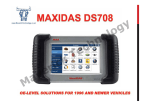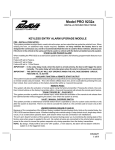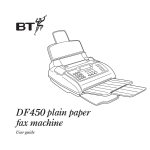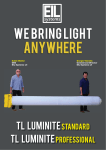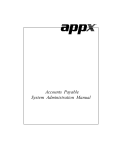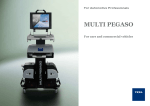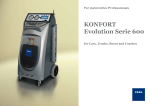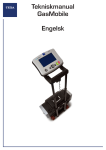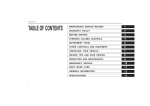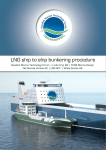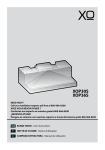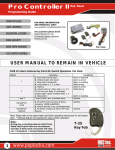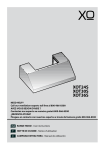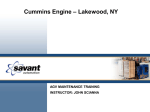Download 2.2 Operator Safety Regulations
Transcript
en ENGLISH...............................................................5 2 en SUMMARY Introduction........................................................................................5 1 LEGEND OF THE SYMBOLS USED...........................................6 2 GENERAL SAFETY REGULATIONS..........................................7 2.1 Glossary..........................................................................................7 2.2 Operator Safety Regulations...........................................................7 2.2.1 General Safety Regulations................................................................7 2.2.2 Risk of Asphyxiation............................................................................7 2.2.3 Risk of Impact and Crushing...............................................................8 2.2.4 Hazards Caused by Moving Parts......................................................8 2.2.5 Risk of Burning or Scalding................................................................8 2.2.6 Fire and Explosion Hazard.................................................................9 2.2.7 Noise Hazard......................................................................................9 2.2.8 High Voltage Hazard...........................................................................9 2.2.9 Poisoning Hazard.............................................................................10 2.3 General User and Maintenance Warnings....................................11 3 SPECIFIC SAFETY RULES FOR INSTALLING TMD2.............12 3.1 Glossary........................................................................................12 3.2 General Rules...............................................................................12 3.3 Operator Safety.............................................................................13 3.4 Device Safety................................................................................14 3.5 Safety during the Installation.........................................................15 4 ENVIRONMENTAL INFORMATION..........................................17 5 OPERATION OF THE TOOL'S RADIO DEVICES.....................18 6 NORMATIVE INFORMATION....................................................19 7 DESCRIPTION...........................................................................20 7.1 Image of the device.......................................................................21 7.2 Technical Features........................................................................22 7.3 Flash codes...................................................................................23 7.3.1 Flashings of LED - [a] and of LED - [b].............................................23 3 7.3.2 Flashings of LED - [c] with instrument panel on ..............................23 8 INSTALLATION..........................................................................25 8.1 Suggestions for a Correct Installation...........................................26 8.2 External GPS Antenna Positioning (Optional)...............................27 8.3 Connection of the External GPS Antenna to TMD2......................28 8.4 Positioning of TMD2......................................................................30 8.5 Power Supply Connections...........................................................35 8.6 Checking the Installation...............................................................36 9 CONFIGURATION.....................................................................37 9.1 Configuration through TMDStarter................................................37 9.2 Configuration through the Portal...................................................38 10 MAINTENANCE.......................................................................39 11 INDICATIONS IN CASE THE VEHCILE IS NOT USED FOR A LONG TIME.....................................................................................40 12 LEGAL NOTICES.....................................................................41 4 en TMD2 INSTALLATION MANUAL Introduction Dear Installer, Please read through the instructions in this manual carefully and keep it for future reference. Reading and understanding the following manual will help you to avoid damage or personal injury caused by improper use of the product to which it refers. TEXA S.p.A reserves the right to make any changes deemed necessary to improve the manual for any technical or marketing requirement; the company may do so at any time without prior notice. This manual should be considered an integral part of the product to which it refers. In the case it is resold the original buyer is therefore required to forward the manual to the new owner. Reproduction, whole or in part, of this manual in any form whatsoever without written authorization from the producer is strictly forbidden. © copyright and database rights 2010. The material contained in this document is protected by copyright and database rights. All rights reserved according to law and international agreements. 5 1 LEGEND OF THE SYMBOLS USED The symbols used in the manual are described in this chapter. Asphyxiation Risk Explosion Risk High Voltage Hazard Fire / Burn risk Poisoning Hazard Corrosive Substances Risk Noise Hazard Moving Parts Risk Crushing Risk General Risk Important information 6 en 2 GENERAL SAFETY REGULATIONS 2.1 Glossary • • • Operator: qualified person responsible for installing the tool. Device: the purchased product. Workplace: the place where the operator must carry out her/his work. 2.2 Operator Safety Regulations 2.2.1 General Safety Regulations • • • • • • • The operator must be completely clear-headed and sober when using the device; taking drugs or alcohol before or while operating the device is strictly forbidden. The operator must not smoke during device operation. The operator must carefully read all the information and instructions in the technical documents provided with the tool. The operator must follow all the instructions provided in the technical documents. The operator must make sure she/he is working in an environment which is suitable for the operations that must be carried out. The operator must report any faults or potentially hazardous situation in connection with the workplace or the device. The operator must carefully follow the safety regulations required for the workplace in which she/he is working in and for the operations she/he has been asked to carry out. 2.2.2 Risk of Asphyxiation Exhaust gases from internal combustion engines, whether petrol or diesel, are hazardous to your health and can cause serious harm to your body. Safety Precautions: • • The workplace must be equipped with an appropriate ventilation and air extraction system and must be in compliance with standards according to current national laws. Always activate the air extraction system when working in closed environments. 7 2.2.3 Risk of Impact and Crushing The vehicles which are undergoing A/C system recharging operations and the devices must be properly blocked during service, using the specific mechanical brakes. Safety Precautions: • • • • Always make sure that the vehicle is in neutral gear (or that it is set in parking position in case of a vehicle equipped with automatic transmission). Always activate the hand brake or parking brake on the vehicle. Always block the wheels on the vehicle with the specific mechanical brakes. Make sure the device is stable, on a flat surface and that the wheels are locked with the specific brakes. 2.2.4 Hazards Caused by Moving Parts Vehicle engines include parts that move, both while running and when off (ex: the cooling fan is controlled by a thermal switch in connection with the coolant temperature and can be activated even when the vehicle is off), that can injure the operator. Safety Precautions: • • • • Keep hands away from moving parts. Disconnect the engine cooling fan each time the engine you are working on is still hot. This will avoid the fan from being unexpectedly activated even when the engine is off. Do not wear ties, loose clothes, wrist jewellery or watches when working on a vehicle. Keep connection cables, probes and similar devices away from the moving parts of the engine. 2.2.5 Risk of Burning or Scalding The parts that are exposed to high temperatures in engines that are running or have just stopped could burn the operator. Remember that catalytic mufflers reach very high temperatures, able to cause serious burns or even start fires. Acid in the vehicle batteries is another potential hazard. Safety Precautions: • • 8 Protect your face, hands, and feet by using suitable protection. Avoid contact with hot surfaces, such as spark plugs, exhaust pipes, radiators and connections within the cooling system. en • • Make sure there are no oil stains, rags, paper or other inflammable material near the muffler. Avoid splashing electrolyte on skin, eyes and clothes, as it is a corrosive and highly toxic compound. 2.2.6 Fire and Explosion Hazard The following are potential fires and/or explosion hazards: • • • The types of fuel used by the vehicle and the vapours released by these fuels. The refrigerants used by the A/C system. The acid in the vehicle batteries. Safety Precautions: • • • • • • • • • • Let the engine cool. Do NOT smoke near the vehicle. Do NOT expose the vehicle to open flames. Make sure that the electrical connections are all well insulated. Collect any fuel that might have spilled. Collect any refrigerant that might have spilled. Make sure you are always working in an environment equipped with a good ventilation and air extraction system. Always activate the air extraction system when working in closed environments. Cover the openings of the batteries with a wet cloth in order to stifle the explosive gases before proceeding in testing or recharging. Avoid causing sparks when connecting cables to the battery. 2.2.7 Noise Hazard Loud noises that may occur within the workplace, especially during service operations, may damage the operator's hearing. Safety Precautions: • Protect your ears with suitable protective ear wear. 2.2.8 High Voltage Hazard The voltage supply from the mains that powers the devices in the workplace and the voltage within the vehicle starter system are a potential shock hazard to the operator. 9 Safety Precautions: • • • • • • • • Make sure the electrical system in the workplace is compliant to current national standards. Make sure the device being used is connected to ground. Cut off the power supply voltage before connecting or disconnecting cables. Do NOT touch the high voltage cables when the engine is on. Operate in conditions of insulation from ground. Work with dry hands only. Keep conductive liquids away from the engine while working. Never leave tools on the battery in order to avoid accidental contacts. 2.2.9 Poisoning Hazard The hoses used to extract the gases can release toxic gases, dangerous to the operator if exposed to temperatures higher than 250 °C or in case of a fire. Safety Precautions: • • 10 Contact a doctor immediately should you inhale these gases. Use neoprene or PVC gloves when eliminating combustion deposits. en 2.3 General User and Maintenance Warnings When using the device or carrying out scheduled maintenance (ex.: fuse replacement) on the device, carefully follow the information provided below. • • • • • • • Do not remove or damage the labels and the warnings on the device; do NOT in any case make them illegible. Do not remove or block any safety device the purchased product is equipped with. Only use original spare parts or spare parts approved by the manufacturer. Contact your retailer for any non-scheduled maintenance. Periodically check the electrical connections of the device, making sure they are in good condition and replacing any damaged cables. Periodically check parts that are subject to wear and replace them if necessary. Do not open or disassemble the device. 11 3 SPECIFIC SAFETY RULES FOR INSTALLING TMD2 The technology used for the design and the production inspection of the TMD2 devices and related accessories, make them reliable, simple and safe to install and use. The personnel qualified to install telediagnostic devices is required to follow the general safety rules, to employ the TMD2 devices and related accessories for their intended use only. and to preserve the correctly, as described in this manual. 3.1 Glossary Operator: a qualified person responsible for installing the telediagnostic device. Device: any TMD2 device. Wiring: specific electric cables needed to connect TMD2 to its accessories, to the power supply, to the antenna, etc. 3.2 General Rules • • 12 The operator must have basic knowledge of mechanics, automotive industry, car repairs and of the potential dangers that can occur during installation operations. The operator must carefully read and understand the information and the instructions in the technical documents provided with the device. en 3.3 Operator Safety The airbags inflate with great force and a device placed in their expansion area may be projected towards the occupants of the vehicle causing serious harm and injuries. Safety Measures: • Do not place the device in the expansion areas of any airbag. The device was manufactured to be electrically safe and insulated. It is however necessary to reduce the risk of electric shock. Safety Measures: • • • Make sure the electric power supply devices (auxiliary batteries) are disconnected and that they remain so during the entire installation before proceeding with the installation itself. Do not touch the device, the accessories and the wiring with wet hands. If liquid should penetrate inside the device, immediately disconnect the power supply wiring and contact technical assistance. The device's antenna was manufactured to result be electrically safe and mechanically resistant. However, if the antenna is damaged in some way, the contact with skin could cause light burns. Safety Measures: • • • Do not use the accessory device if the antenna is damaged. Do not touch the antenna with bare hands. Immediately contact technical assistance. 13 3.4 Device Safety The device was manufactured to be mechanically resistant. Careless use and excessive mechanical stress could compromise its efficiency. Safety Measures: • • • • • • • Do not drop, shake or knock the device. Do not place objects over the cables and do not bend them at a right angle. Do not perform any type of intervention that could damage the device. Do not open or disassemble the device. Do not fold the device's antenna. Use the device only with the provided antenna or with one authorized by the device's manufacturer. Make sure the device and the accessories connected to it are firmly secured before moving the vehicle they are installed on. The device was manufactured to be electrically safe and to work with specific power supply voltage levels. The failure to comply with the specifications related to the power supply may compromise its efficiency. Safety Measures: • • • • Do not wet the device with water or other liquids. If not otherwise specified, use the device on vehicles with a 12/24 V DC power supply and the chassis connected to the negative pole. The device's power supply must always be connected following the indications provided in this manual. Do not use an external batteries to supply the device. Electromagnetic compatibility tests on the device guarantee that it can be adapted to the technologies normally used on vehicles (ex.: engine check, ABS, airbag, etc.). Nevertheless, if there are malfunctions, contact the vehicle dealer. In particular, the correct functioning of the device could be compromised by covering the antenna with shielding objects and/ or materials. Such materials force the device to work with more power than normal. Safety Measures: • 14 Do not cover the antenna with shielding objects or materials. en 3.5 Safety during the Installation The device was manufactured to be used in specific environmental conditions. The installation and use of the device in environments with temperature and humidity features different from those specified could compromise its efficiency. Safety Measures: • • • • Store the device in a dry area and away from dust. Do not expose or install the device near sources of heat. Position the device in order to guarantee its proper ventilation. Do not use corrosive chemicals, solvents or harsh detergents to clean the device. The installation of the device was carefully tested by qualified personnel in TEXA. You must follow some indications provided by the vehicle manufacturer in order to install the device correctly. Safety Measures: • • Follow the indications provided in the vehicle's manual carefully to disassemble the plastic parts and the access to the compartments. Respect the safety distances from the systems with the following functions: • airbag; • ABS; • speed limiter; • seat belt pretensioners. The installation of the device requires a connection to the vehicle's electrical system. Perform the connection to the vehicle's electrical system making sure not to compromise the safety and its correct functioning. Safety Measures: • • • • Insulate each of the device's connections to the vehicle's electrical system. Equip the openings crossed by cables with fairleads. Do not compromise in any way the quality of the electrical and mechanical OEM wiring. Make sure the electric cables, the wiring in general, the fuel hydraulic pipes and the safety pneumatic devices of the vehicle are not damaged during the installation. 15 • • • Make sure the installation does not compromise the correct functioning of the vehicle's controls, in particular the brakes and, in general, the safety devices. Do not connect to the electric circuits of systems with the following functions: • airbag; • ABS; • speed limiter; • seat belt pretensioners. Do not change the current flow of an OEM circuit by cutting it off, increasing it or mechanically changing it cables if not permitted by the vehicle manufacturer. The device must be installed so that it works correctly and safely. Safety Measures: • • • • • Avoid contact between the device and vibrating parts of the vehicle. Do not spread out the wiring with the cables stretched. Do not spread out the wiring in walkable areas or in areas that are subject to friction without the necessary protections. For the installation you must use only the wiring and the components provided with the device. Put the antenna at a minimum distance of 20 cm from the positions of the vehicle's passengers. At the end of the installation, you must restore the initial conditions of the vehicle. Safety Measures: • • • • 16 Restore each OEM electrical connection. Restore each OEM device (ex.: compartment covers). Replace the fastening elements that are damaged. Restore any OEM anti-corrosion systems. en 4 ENVIRONMENTAL INFORMATION For information regarding the disposal of this product please see the pamphlet supplied. 17 5 OPERATION OF THE TOOL'S RADIO DEVICES Wireless connection with Bluetooth, WiFi and HSUPA technology Wireless connectivity through Bluetooth, WiFi and HSUPA is a technology that supplies a standard, reliable method for exchanging information between different devices using radio waves. Many other products besides those built by TEXA use this technology, such as mobile phones, portable devices, Computers, printers, cameras, Pocket PCs etc. The Bluetooth, WiFi and HSUPA interfaces search for compatible electronic devices based on the radio signals they emit and establish a connection. TEXA tools only select and prompt compatible TEXA devices. This does not exclude the presence of other sources of communication or disturbance. THE EFFICIENCY AND QUALITY OF BLUETOOTH, WiFi AND HSUPA COMMUNICATION MAY BE AFFECTED BY THE PRESENCE OF RADIO DISTURBANCE. THE COMMUNICATION PROTOCOL IS DESIGNED TO MANAGE THESE TYPES OF ERRORS; HOWEVER, IN SUCH CASES COMMUNICATION MAY BE DIFFICULT AND CONNECTION MAY REQUIRE SEVERAL ATTEMPTS. SHOULD THE WIRELESS CONNECTION ENCOUNTER SERIOUS PROBLEMS AND COMPROMISE REGULAR COMMUNICATION, THE SOURCE OF THE ENVIRONMENTAL ELECTROMAGNETIC DISTURBANCE MUST BE IDENTIFIED AND ITS INTENSITY REDUCED. Position the tool so that the radio devices it is equipped with can work properly. In particular, do not cover it with any shielding or metallic materials in general. 18 en 6 NORMATIVE INFORMATION Declaration of Conformity TEXA S.p.A. hereby declares that the TMD2 complies with the essential requirements and with all further provisions as defined by the 1999/5/EC regulation. A copy of the complete Declaration of Conformity can be obtained at: TEXA S.p.A., Via 1 Maggio 9, 31050 Monastier di Treviso (TV), Italy Antennas This product was designed and tested to work with the provided antennas. In order to guarantee the compliance with the above mentioned regulations, use the appliance only with the provided antennas or with other antennas authorized by TEXA S.p.A. 19 7 DESCRIPTION TMD2 is a GPS localization device able to communicate via Bluetooth with other diagnosis devices. The TMD2 Kit includes: • • • • 20 TMD2. External GPS antenna (optional). Wiring for the electrical connection. Installation Manual. en 7.1 Image of the device GPS antenna connector Fixing hole Fixing hole LED unit: a) Red LED b) Blue LED c) Green/red dual colour LED 5. Fixing hole 6. L1 - Serial connector 7. L2 - Engine Lock Connector 8. L3 - I/O connector 9. L4 - Power connector 10. Fixing hole 1. 2. 3. 4. To install additional devices, consult the user and installation manuals provided in the packages of each device. 21 7.2 Technical Features Hardware features: CPU: ARM7, 32-bit RISC CPU, 50MHz RAM: 64 KByte FLASH: 256 + 4096 KByte GPRS module: Quad-Band Class 10 GPS module: 50 channels, High sensitivity (-159 dBm), GPS assisted Interfaces: GPS, GPRS, 4 x RS232C (only 2 external ones), Bluetooth (optional) Sensors: motion, 3-axle accelerometer ± 10 g Software features: Operating System: Embedded Real Time Kernel Electrical features: Battery: Li-Ion 1100 mAh rechargeable Power supply: direct from 12/24 V vehicle battery Physical features: Operating temperature: - 20 ÷ 55 °C Storage temperature: - 40 ÷ 85 °C Operation moisture: 10 ÷ 80 % Dimensions: 104x91x33 mm Weight: 0,15 kg Dust/liquid protection: IP 40 Compliances and Regulations: Compliant with the Directive/Regulation ECE ONU R10 22 en 7.3 Flash codes The device uses the flashing of the LEDs to indicate its status. 7.3.1 Flashings of LED - [a] and of LED - [b] The explanation of the correct reading of the flashings of LED - [a] and of LED - [b] is below. LED Status Off No error. On -- Red - [a] Slow flashing (1s) Blue - [b] Problem related to the SIM Card: SIM not present or PIN error. Fast flashing (200 ms) Possible hardware problem: contact Technical Assistance. Off No Bluetooth communication. On -- Flashing Device in Bluetooth. communication via 7.3.2 Flashings of LED - [c] with instrument panel on LED - [c] may take on two colours: green and red and it may also flash with different frequencies. During normal operating conditions, when the device is connecting to the server to send data, the LED - [c] will flash 3 times in a continuous cycle. Each series of flashings is approximately 2 s after the previous one. The three flashings indicate respectively the status of: 1. 2. 3. The reception of the position signal from the GPS satellites. The connection to the GPRS network. The connection to the TEXA S.p.A. Data Center. 23 The colour of l LED - [c] when it flashes indicates the status of the operation/connection (see chart). Flashing Red LED Green LED 1st Invalid GPS position*. Valid GPS position. 2nd Invalid GPRS connection**. Valid GPRS connection. 3rd Invalid connection to the TEXA Data Valid connection. Center. (*)INVALID GPS POSITION: This could be due to the vehicle parked in a closed area or passing through a dead zone where the flow of the data coming from the satellites is missing or affected by many interferences (ex.: military areas). (**)INVALID CONNECTION WITH TEXA DATA CENTER: This could be due to a problem with the telephone or Internet service providers caused by ordinary/extraordinary maintenances on the network, by the weather conditions or by the passage in an area not covered by the GPRS signal. 24 en 8 INSTALLATION The following chapters describe the installation procedure of TMD2. Please read the following manual carefully and completely before proceeding with the installation. The installation must be performed by qualified personnel only. For the installation you need: • • • • • • • • Scissors and a wire stripper. Flat-tip and Phillips screwdriver (medium). A 12mm hole saw for the hole, if required, to pass the wiring cable pass from the engine compartment to the passenger compartment. 5mm drill bit for the assembly screws. Plastic cable ties. Pliers for cable terminals. Square tip pliers. A PC connected to Internet to programme the TMD2 control unit. The installation requires the following steps: 1. 2. 3. 4. 5. 6. Reading of the installation and user manual. Planning of the correct positioning of the GPS antenna (if external). Planning of the device positioning. Power supply connections. Connection of the wiring to the device. Configuration. 25 8.1 Suggestions for a Correct Installation When choosing the most suitable place to locate the device, we recommend you take the following considerations into account. A first bond is that imposed by the correct positioning of the external GPS antenna: for an optimal functioning of the device you must put the antenna in an appropriate position. The second bond is the distance between TMD2 and the external diagnosis device. Consider that the coverage range of the devices equipped with Bluetooth technology inside the vehicle's passenger compartment is approximately 3 metres. TMD2 should be put in a position that allows an easy connection of the diagnostic wiring yet maintaining an appropriate distance that does not expose the device to the direct heat from the engine. Consider that the diagnostic wiring (cod. 3903733) is approximately 3 metres long. 26 en 8.2 External GPS Antenna Positioning (Optional) TMD2 works with two types of antennas. The technologies used are GPS, for the reception of information via satellite, and GPRS, for data communication between the device installed on the vehicle and the fleet manager. The GPRS antenna is always inside the device while the GPS one can also be external (optional). The best place to position the GPRS antenna is on the vehicle's roof and it can be fastened with glues, double-sided tape or with the magnet it is provided with, by placing it on a metallic surface. When installing the antenna, remember that the higher the position with respect to the ground, the better the efficiency of the signal reception. If you are installing the device inside the vehicle, the GPS antenna must be placed where it is not covered by metallic parts or by other materials that would screen the radio waves. Furthermore make sure you position it with its top side up, possibly sky-facing. If the cable provided is long enough, the best place to install the GPS antenna is near the windshield. The GPS antenna must be connected to the device only with the provided connection cable. 27 8.3 Connection of the External GPS Antenna to TMD2 The instructions for the connection of the GPS antenna are provided below. You need to connect the GPS antenna before positioning TMD2, in order to be sure that the antenna and the device are close enough. Do not shorten the coaxial cable of the GPS antenna. Do not run the antenna cable near moving gear and mechanisms, in order to prevent the cable from being damaged. Do not cover the GPS antenna with shielding or metallic materials. Do not fasten the GPS antenna near other antennas or other radio devices (ex.: CBs, Radars, mobile phones, etc.). If you intend to position the GPS antenna inside the passenger compartment, make sure the vehicle's windows are not screened. Otherwise, you should find a spot with non-screened glass identifiable by a different transparency. Proceed as follows: 1. Remove the rubber cap that protects the connector. 2. Insert the connector of the external GPS antenna connector into the device's connector by slightly pressing it until you hear a "click". 28 en 3. Fix the antenna so that the upper plastic part is sky-facing. 29 8.4 Positioning of TMD2 Once you have decided where to position the antenna, and you have located the power supply connections, you must find the most appropriate place to fasten the device. When positioning the device, you must respect the following general rules: • • • • • It must be far from sources of heat. It must be in a dry place and far from moisture and water. It must be close enough to allow the connection to diagnosis devices. It must be in a place where the internal antennas are not shielded. It must be in a perpendicular position with respect to the vehicle's moving direction. The device is provided with an inertial sensor for the detection of accidents. The axles of the device must match the vehicle axles in order to use the inertial sensor (Accident alarm): • • • Longitudinal axle - driving direction. Transverse axle - perpendicular to the driving direction. Gravitational axle - vehicle height. Use the specific fixing holes only to fasten the device. The use of velcro or other supports could change the correct activation of the inertial sensor. 30 en The image below shows the vehicle's axles. The image below shows the device's axles. 31 Some examples of where to position the device are provided below. Example 1: the axles of TMD2 match the vehicle's axles. Example 2: the axles of TMD2 match the vehicle's axles. 32 en Example 3: the axles of TMD2 match the vehicle's axles. Example 4: the axles of TMD2 do NOT match the vehicle's axles, therefore it is an incorrect positioning. 33 Proceed as follows: 1. 2. 3. 4. 34 Locate the most appropriate position to fasten the device. Make sure the GPS antenna cable is easily connectible and is not too stretched. Make sure the device is oriented correctly. Fasten the device with specific screws. en 8.5 Power Supply Connections To power TMD2 use the specific cable provided (code 3903929) with the device. Do not connect the connector to TMD2 until the entire system is completed. Use the cable with the loose wires. Proceed as follows: 1. 2. Identify the red wire (+30 VBatt.), the yellow wire (15, ignition terminal) and the black wire (ground). The power supply for the +30 VBatt line must be drawn directly from the vehicle's battery. Make sure the +30 V and ground power supplies are correct, in order to avoid the arising of false alarms from the TMD2 control unit (discharged battery alarm, power supply disconnection alarm). 35 8.6 Checking the Installation Once you have completed all the operations described in the previous chapters, you must make sure the installation has performed correctly. Proceed as follows: 1. 2. Connect the TMD2 power supply connector and turn the vehicle's to the “ON” position. The LED located on the top cover of TMD2 starts to flash. If the LED does not turn on, make sure the power supplies were connected correctly. 36 en 9 CONFIGURATION At the end of the installation, TMD2 is able to work immediately as a GPS localizer. In order to use the advanced functions of TMD2, you must carry out a configuration procedure. You may configure TMD2 through: • • the TMDStarter software, the on-line portal. 9.1 Configuration through TMDStarter You can perform the configuration of TMD2 using the specific TMDStarter software. To connect TMD2 to the PC, you must use the specific cable (code 3903929) provided with the device. The installation cable contains electronic components at the bottom of the USB connector, therefore is must be handled with care. Do not disconnect the connector from the USB socket by yanking it Avoid folding the cable at the bottom of the USB connector. For more information consult the TMDStarter software operating manual. 37 9.2 Configuration through the Portal TMD2 may be configured remotely through the TMD portal. All the operations performed automatically through TMDStarter may be conducted through the portal. The portal may be eventually used to correct wrong configurations. The access to the configuration pages within the portal is linked to the rights granted to the user you perform the login with. For more information contact Technical Assistance. 38 en 10 MAINTENANCE In order to guarantee a correct functioning of TMD2 and of the accessories connected to it, you must perform regular checks on the device. We remind the operator to carry out the tests with the utmost care, making sure he is working in total safety during all of the steps (see General Rules for the Safety of Operators in this manual, also). Maintenance interventions must be performed within 15 days from the installation of the TMD2 and then every 6 months. In particular: • • • • Carry out a visual check of all the devices installed. Make sure the device is not damaged; make sure all covers/plastic parts are properly fastened; make sure no wiring is cut and/or damaged, no connectors are disconnected and/or loose. Furthermore make sure the antennas are properly fixed in their installation housings. Make sure the connections are not damaged, oxidised, exposed to atmospheric agents, water and humidity. Make sure all screws and bolts used to fasten TMD2 and the external GPS antenna are not damaged and are properly tightened. If the wiring or the connections have been exposed to atmospheric agents, water and moisture, proceed with the waterproofing. In case of damaged cables, contact TEXA S.p.A. in order to have them replaced. For any fault or complication, contact the TEXA S.p.A. assistance service immediately. 39 11 INDICATIONS IN CASE THE VEHCILE IS NOT USED FOR A LONG TIME The correct functioning of TMD2 as geolocalizer requires the device to be constantly powered even when the vehicle is stationary, the engine is off and the ignition key is not inserted. In these conditions TMD2 continue to absorb current from the vehicle's battery. TMD2 was designed to optimise consumptions, however if the vehicle is not used for a long period of time, it could sensibly lower the charge level of the battery. Refer to the instructions provided in the user and maintenance manual if the vehicle is not used for a long time. If the vehicle is not used for a long period of time, you may disconnect TMD2 from the power supply. If you make this choice, you must disconnect the internal batteries of the device also. This operation may be performed through a specific software control and without physically opening the device. For more information contact TEXA S.p.A. assistance service. 40 en 12 LEGAL NOTICES TEXA S.p.A. Via 1 Maggio, 9 - 31050 Monastier di Treviso - ITALY Cod. Fisc. - No. of Companies' Register of Treviso - Part. IVA: 02413550266 Single member company and subject to management and co-ordination of Opera Holding S.r.l. Share capital of 1.000.000 € i.v. - R.E.A. N. 208102 Legal Representative Bruno Vianello Phone +39 0422.791.311 Fax +39 0422.791.300 www.texa.com For information regarding the legal notices, please refer to International Warranty Booklet provided with the product in your possession. 41










































